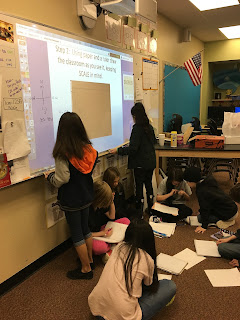This is the question students at Colorado STEM Academy in Westminster, Colorado have been trying to answer. Over the past several months, students, teachers and scientists have been working together to raise awareness about current marine issues plaguing the planet.
| Giuliana Turi, modeler for NOAA |
| Students on presentation day |
Problem-based learning is an instructional method which allows students to learn deeply through a current problem. In this case, that problem was convincing people inland that they, too, should care about the ocean, even if they do not live near it. After choosing a marine issue that they were passionate about, students formed groups to learn about their marine issue and share their knowledge with their community. Students enlisted help from NOAA, National Geographic, and several other organizations on the World Wide Web. They also contacted local scientists in the Denver/Boulder area. Armed with information and resources, the teams worked together to understand their issue and how it could impact the community where they live.
| Handouts created by students to teach people about making sustainable seafood choices |
| Students presenting to ocean scientists |
Throughout this learning process, the question arose: How could students share their project with their community? The Downtown Denver Aquarium provided the perfect opportunity and invited students to share their projects at a nighttime event. The students, on their “Marine Mission”, began to brainstorm how they could share their learning about the marine issues with the community. They took on roles as web developers, topic experts and graphic designers to create a website and product that would help raise awareness about their marine issue. With the help of a local printing company, students created professional bookmarks, business cards, pamphlets, postcards, hats and T-shirts to pass out to visitors, with links that directed them to their websites with more information about the marine issue.
| Students learning about sharks at the aquarium |
On the presentation night at the Downtown Aquarium, students presented their projects to families and friends, scientists and educators, and other community members that stopped by the room. Visitors and scientists from the Colorado Ocean Coalition, Ocean First Education and Ocean First Institute also joined the students to share about sharks, marine debris, and making sustainable seafood choices. To say our visitors were “wowed” by these students would be an understatement. Everyone left with a smile on their face, enthusiasm in their voices, and a little ocean in their hearts.
| Our team of teachers and ocean scientists |
Thank you Cathy Christopher, Mikki McComb-Kobza, Laurent Riegler, Diane Stanitski, Guiliana Turi, Ocean First Education, Ocean First Institute, Colorado Ocean Coalition and NOAA for helping to make this project a success for students and teachers at the Colorado STEM Academy!






